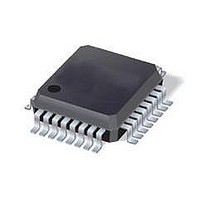ST7FLI49MK1T6 STMicroelectronics, ST7FLI49MK1T6 Datasheet - Page 109

ST7FLI49MK1T6
Manufacturer Part Number
ST7FLI49MK1T6
Description
MCU 8BIT SGL VOLT FLASH 32-LQFP
Manufacturer
STMicroelectronics
Series
ST7r
Datasheet
1.ST7FLI49MK1T6TR.pdf
(187 pages)
Specifications of ST7FLI49MK1T6
Core Processor
ST7
Core Size
8-Bit
Speed
8MHz
Connectivity
I²C
Peripherals
LVD, POR, PWM, WDT
Number Of I /o
24
Program Memory Size
4KB (4K x 8)
Program Memory Type
FLASH
Eeprom Size
128 x 8
Ram Size
384 x 8
Voltage - Supply (vcc/vdd)
2.4 V ~ 5.5 V
Data Converters
A/D 10x10b
Oscillator Type
Internal
Operating Temperature
-40°C ~ 85°C
Package / Case
32-LQFP
Processor Series
ST7FLI4x
Core
ST7
Data Bus Width
8 bit
Data Ram Size
384 B
Interface Type
I2C
Maximum Clock Frequency
8 MHz
Number Of Programmable I/os
24
Number Of Timers
5
Maximum Operating Temperature
+ 125 C
Mounting Style
SMD/SMT
Minimum Operating Temperature
- 40 C
On-chip Adc
10 bit, 10 Channel
Lead Free Status / RoHS Status
Lead free / RoHS Compliant
Available stocks
Company
Part Number
Manufacturer
Quantity
Price
Company:
Part Number:
ST7FLI49MK1T6
Manufacturer:
st
Quantity:
456
Company:
Part Number:
ST7FLI49MK1T6
Manufacturer:
STMicroelectronics
Quantity:
10 000
Part Number:
ST7FLI49MK1T6
Manufacturer:
ST
Quantity:
20 000
Company:
Part Number:
ST7FLI49MK1T6TR
Manufacturer:
STMicroelectronics
Quantity:
10 000
ST7LITE49M
Mode selection
The interface can operate in the four following modes:
●
●
By default, it operates in slave mode.
The interface automatically switches from slave to master after it generates a START
condition and from master to slave in case of arbitration loss or a STOP generation, allowing
then Multi-Master capability.
Communication flow
In Master mode, it initiates a data transfer and generates the clock signal. A serial data
transfer always begins with a start condition and ends with a stop condition. Both start and
stop conditions are generated in master mode by software.
In Slave mode, the interface is capable of recognizing its own address (7 or 10-bit), and the
general call address. The general call address detection may be enabled or disabled by
software.
Data and addresses are transferred as 8-bit bytes, MSB first. The first byte(s) following the
start condition contain the address (one in 7-bit mode, two in 10-bit mode). The address is
always transmitted in Master mode.
A 9th clock pulse follows the 8 clock cycles of a byte transfer, during which the receiver must
send an acknowledge bit to the transmitter. Refer to
Figure 55. I
Acknowledge may be enabled and disabled by software.
The I
The speed of the I
I
SDA/SCL line control
Transmitter mode: the interface holds the clock line low before transmission to wait for the
microcontroller to write the byte in the data register.
Receiver mode: the interface holds the clock line low after reception to wait for the
microcontroller to read the byte in the data register.
The SCL frequency (F
the I
2
C (up to 400 kHz).
2
Slave transmitter/receiver
Master transmitter/receiver
2
C bus mode.
C interface address and/or general call address can be selected by software.
SCL
SDA
CONDITION
2
C bus protocol
START
2
C interface may be selected between Standard (up to 100 kHz) and Fast
scl
) is controlled by a programmable clock divider which depends on
MSB
1
Doc ID 13562 Rev 3
2
8
Figure
ACK
9
55.
CONDITION
STOP
On-chip peripherals
109/188













